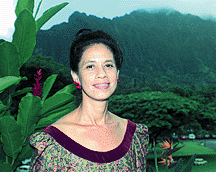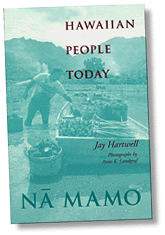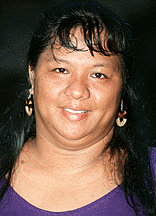
Three of the Hawaiians featured in
Jay Hartwell’s ‘Na Mamo’:

This insightful book portrays ordinary people whose lives are ennobled by their pride in being Hawaiian."
Mahealani Kamauu
Executive director,
Native Hawaiian Legal Corporation
 "Mamo" is the Hawaiian word for descendant. And "Na Mamo: Hawaiian People Today" examines 12 descendents whose stories present a freeze frame of contemporary Hawaiian history.
"Mamo" is the Hawaiian word for descendant. And "Na Mamo: Hawaiian People Today" examines 12 descendents whose stories present a freeze frame of contemporary Hawaiian history.
The project reveals author Jay Hartwell's remarkable sensitivity to things Hawaiian and his uncanny knack for knowing what should be reported.
"Na Mamo" showcases Moon Kauakahi, an original member of Makaha Sons of Ni'ihau; Mapuana and Kihei deSilva of Halau Mohala 'Ilima, perennial Merrie Monarch participants; and nine other descendents:
 Polynesian canoe paddler Albert Kamila Choy Ching Jr.
Polynesian canoe paddler Albert Kamila Choy Ching Jr.
 The late traditional healer William Kalunakeaki Kahu'ena.
The late traditional healer William Kalunakeaki Kahu'ena.
 Hawaiian rights activist and poet Mahealani Kamauu.
Hawaiian rights activist and poet Mahealani Kamauu.
 Kauai taro farmer Clarence Eli Kaona.
Kauai taro farmer Clarence Eli Kaona.
 Surfer/lifeguard Brian Lopaka Keaulana.
Surfer/lifeguard Brian Lopaka Keaulana.
 Big Island tapa maker Dennis Kana'e Keawe.
Big Island tapa maker Dennis Kana'e Keawe.
 Lono priest and designer Craig Neff of the Big Island.
Lono priest and designer Craig Neff of the Big Island.
 Hawaiian language teachers Laiana and Lilinoe Wong.
Hawaiian language teachers Laiana and Lilinoe Wong.
The book communicates at many levels and more effectively than do small doses of newspaper copy tossed down amid life's bustle. For example, Clarence Kaona's arduous taro cultivating is depicted in the context of water rights, tourists and hippies, and against the historical sweep of land-tenure issues.
The book is well researched and thoughtfully written. It can be a quick read, but deserves deliberate digestion. The work is enhanced by oli - historical and contemporary Hawaiian chants - and by the black-and-white images of award-winning photographer Anne Kapulani Landgraf.
"Na Mamo" is a significant document, as important as any history lesson descendants may learn in modern-day Hawaii.

A book like this is pretty important as a time marker in the attitudes of the Hawaiians.
Jalyne Lilinoe Kealoha Wong
Teacher, Punana Leo Kawaiaha'o

Showing that people are actually trying to live (while speaking) in Hawaiian is an important concept to get out. With the Punana Leo and Kula Kaiapuni (Hawaiian-language) immersion programs and things in the book's other chapters, people are seeing that this is not about living in the past, this is about being Hawaiian in the present, and recognizing what is Hawaiian and valuing it. For that itself, the book is good.
Kerry Laiana Wong
Hawaiian-language instructor,
University of Hawaii